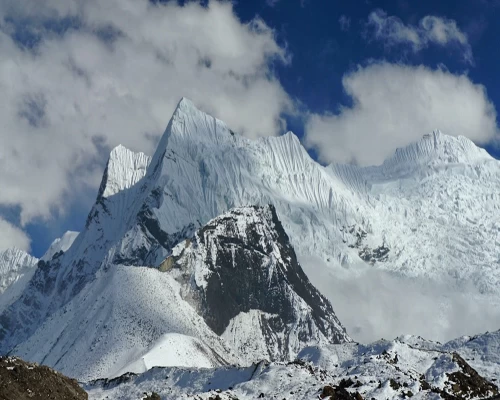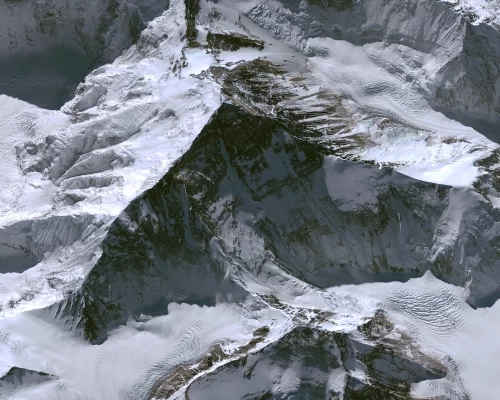Island Peak Climbing with Gokyo and EBC trek is a 22-day Itinerary that offers the perfect mix of nature, beauty, and adventure. It is an experience that all adventurers should experience. On this trip to Nepal, tourists will trek to Gokyo, EBC, and the summit of the Island Peak.
This 22-day trip, in particular, is the ideal combination of trekking and climbing. Eric Shipton, a well-known climber, gave the name Island Peak. He named the mountain Island because, in appearance, it seemed like an island in a sea of ice.
The 22-day climbing of Island Peak through Gokyo and Everest base camp is the most real Himalayan adventure of one's lifetime. This adventurous journey leads you to the magnificent part of the Khumu area, reaching the top of Island Peak (6,189m), a breathtaking Himalayan ascent of splendid views.
The journey starts with a picturesque flight to Lukla and the Khumbu Valley trek. Traverse through the scenic trail of Phakding, Namche Bazaar, with Mount Everest and the other Himalayan mountain chains towering over you. From Namche Bazar, follow the Gokyo Valley Lake trail while passing through landmarks like Dole, Macchermo, and Gokyo.
One hiking challenge up to a high teak Gokyo Ri (5,357m) rewards you with breathtaking views of the mesmerising mountains of Cho Oyu, Gyachung Kang, Lhotse, Makalu, Everest, etc. Cross the challenging pass Cho La Pass (5,420m) from Gokyo before you get to the Everest Base Camp, where you can view the great Everest. The ascent to the Kala Patthar (5,550m) is the last challenge one must face providing travellers with the magical views of Everest.
Then, you'll be retracing the path in the Khumbu Valley for a day or two until Chhukung, and then you'll have your rest as you gear up for your climb. Your experienced Sherpa guides will review your climbing gear as you warm up for summit day. You will finally summit the Island Peak and from the Island Peak base camp which is the main highlight of the whole 22 day trip.
This all-inclusive package is the best for adventure lovers ready to take on the challenge of trekking and peak climbing. Although the route is hard and steep, this 22-day adventure trip is combined with the best destination in the Everest region. No previous climbing or high-altitude experience is required if you are otherwise healthy and physically capable of completing this breathtaking ascent with the trek. Still, we recommend preparing your body for trekking and climbing through different training sessions.
The Island Peak Climbing through Gokyo and EBC is a journey that starts with a trip to the Gokyo Valley via Gokyo and the famous Everest base Camp. For 22 days, you will be reaching the best parts of the Mount Everest region, like Gokyo Ri (5,350m), Cho La Pass (5,420m), Kala Patthar (5,550m), and Everest Base Camp (5,364m) before finally summiting the island peak. With every climb you make, this journey provides 360-degree panoramas of the Himalayas peaks like Everest, Cho Oyu, Lhotse, etc.
If you prefer a climbing and trekking trip experience in one package, choose our best and most memorable Island peak, Climbing Via Gokyo EBC Itinerary. This 22-day program is just the right length to trek and climb through the best part of the Everest region.
We give the detailed route, a map of where the trekking will take place, and the day-to-day itinerary for 22 days. This specially designed program suits both a beginner and an experienced hiker on their way to sumitting Island Peak and exploring the jaw-dropping Gokyo Valley and Everest base camp. Book this Island Peak Climb with trek to Gokyo and EBC in Spring and Autumn months at the best cost for 2025 and 2026.
Island Peak Climbing With Gokyo and EBC Highlights
- Experience the thrill and beauty of the Kathmandu valley and Himalayas when flying from the Lukla flight.
- Explore the largest town in the Khumbu area and encounter Sherpa's life and culture.
- Immerse yourself in the views of the Everest range, including Island Peak and other nearby mountains, all along the way.
- See the traditional culture and the way of life of the Sherpa people.
- If you love hiking to heights, ascend Gokyo Ri for panoramic views and tranquil surroundings.
- Reach Mount Everest Base Camp and come face to face with the gigantic peaks of the Himalayas.
- Hike to Kala Patthar for the sunrise view over the famous Mt Everest.
- Behold the majesty of four 8,000 metres (Everest, Makalu, Cho Oyu, Lhotse) and many 6,000-metre peaks with your own eyes.
- Finish your expedition by summiting Island Peak (Imja Tse).
What Island Peak Climbing with Gokyo and EBC Package Offers?
This 22-day trekking and climbing package offers a fully guided Everest region with porter service, accommodation in guest houses, three meals a day inclusive, and permits to access restricted areas for trekking and climbing. The traveller on this journey will experience the transverse of the culturally diverse Khumbu region while also trying to summit Island Peak (6,189m). The package offers an opportunity to conquer high passes, see glorious mighty Himalayan peaks like Everest, explore Azure Gokyo lakes, and reach one of the popular peaks, Island Peak. Here are some more things that the package offer for it’s traveller:
- This is an opportunity to climb Island Peak (20,305 feet) in Nepal’s Everest region, a famous non-technical peak.
- Before climbing the island's peak trek to the Base Camp of Everest and Gokyo Lakes.
- Various viewpoints at different heights allow one to watch the mighty mountains of the Himalayas, including Mt. Everest, Lhotse, Makalu Cho, Oyu, and many more.
- An eye-catching scenic flight from Kathmandu to Lukla marking the start of the journey in the Khumbu region.
- Acclimatisation before each trek at Namche Bazaar, Gokyo and Island Peak Base Camp.
- Visit glacier lakes in Gokyo Valleys, where the glacial lakes are seen to be bright and shiny.
- Cross one of the famous Cho La Pass (5,380m) from Gokyo to Everest Base Camp route.
- Full support from the company team members by arranging different permits, providing the quality accommodations and meals services etcs.
Can Beginners go for Island Peak Climbing with Gokyo and EBC?
A trip to the Island Peak Climbing with Gokyo and Everest Base Camp can be a truly unforgettable lifetime experience for beginners provided that it is done with the necessary preparation and support.
This climbing journey can be excellent for first-timers as long as adequate pre-climb training is undertaken, followed by instructions from acquired experts. An Island Peak is a 6,189m high mountain that offers its climbers a moderate route that can be used as a beginner destination for mountaineering experience. As the trek takes the scenic route of the Gokyo lakes and the Everest Base camp, the initial night there gives the trekker a chance to adjust to the altitude increase. Here are some more information for beginners to know:
- Island Peak is still not very technical; there are some basic skills that one would need to acquire, such as having a good command of how to use an ice axe, crampons, and ropes. Actually, the beginners will be well-advised to take an introductory mountaineering course.
- For the first time, climbers familiar with climbing with a more experienced, safety-focused, and patient climbing is strongly recommended.
- The beginner should achieve a certain physical condition. The summit day will include an early start, moving forward, while you will be at risk of getting fatigued because it will take you more than 8 hours of climbing.
Island Peak Climbing with Gokyo and EBC Itinerary and Acclimatization Days
Join Mountain Rock Treks on the amazing journey filled with awe and excitement with the organised Island Peak Climbing with Gokyo and EBC itinerary. With the support of our team of professionals, we have put together a plan that prioritises safety, ensures fun, and offers you the best chance at Island Peak Climbing success.
We put your health first by creating an acclimatisation program with three allocated days. It thus gives your body enough time to adapt to the gradual increase in altitude, lowering the possibility of altitude sickness. One more day is dedicated to climbing practice. This part of the course aims to build up your confidence and knowledge about the technical side of the Island Peak climb. We provide you with a complete map of the trekking region, marking the most important points and letting you see the entirety of the path. The altitude graph also makes it easy to understand elevation gain on the route.
This itinerary can be customised to understand that every adventurer is unique. Feel free to discuss any customization requests with our team. We can tailor the itinerary to your preferred pace, interests, and group size.
Is Island Peak Climbing with Gokyo and Everest Base Camp Right for You?
Yes, this action-packed itinerary could be the perfect choice for you, and here is why:
- This journey may be the right one for you if you are a trekker with prior high-altitude trekking experience (above 3,000 metres). A good physique with no medical conditions is preferred.
- If you dream of adventures and want a unique combined path in the Everest region.
- What drives you are simply stunning views of mountain ranges like the Himalayas with snow-capped peaks, even Everest, and glaciers and lakes like turquoise Gokyo lakes.
- The hiking and climbing trail may not suit you if you are not physically fit, are not particularly fond of camping, or are not flexible in your accommodation preferences.
- Island Peak (or Imja Tse – 6189 m) is an attainable challenge for those who do not wish to experiment with the higher summits.
- Gokyo Lakes and Gokyo Ri (5,357 m) are some of the most popular destinations on the trek. The godlike view the mountains offer, especially Mt. Everest and magnificent mountains are seen.
- This trek will take you to Mount Everest base camp (5,364m), where you will feast your eyes on the Khumbu glacier and mighty Mount Everest from a stone's throw distance.
- The route is a unique opportunity to be acquainted with the Sherpas and to receive their warmth and kindness along the roads of different trails. As they walk on, the group pauses for tea and has a chat with the locals.
Island Peak Climbing with Gokyo and Everest Base Camp Cost Update
Island Peak Climbing with Gokyo and Everest Base Camp package cost starts at $2200 per person.
This travel has the flexibility that comes with it. You will find the price still affordable whether you are an individual or a group, bearing in mind that the packages include all the essentials such as good accommodations, delicious meals, professional guides, porters and even climbing Guides for Island Peak. This entails security above all. We at Mountain rock treks provide solo, private or group climbing and trekking trips from Pokhara to Everest region. Here are the group prices we offer below in 2025 and 2026.
No Of Pax | Cost Per Person | Status |
|---|---|---|
| 1 | $2200 | Available |
| 2-4 | $2100 | Available |
| 5-10 | $2000 | Available |









